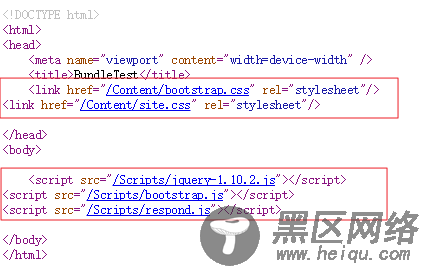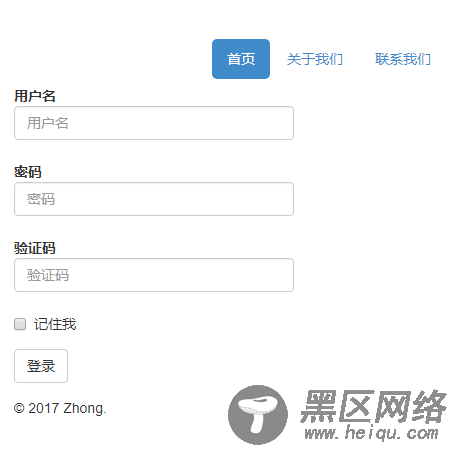ASP.NET MVC中Bundle是用于打包捆绑资源的(一般是css和js),它是在全局文件Global.asax.cs中注册Bundle,而注册的具体实现默认是在App_Start文件夹的BundleConfig.cs中
public class MvcApplication : System.Web.HttpApplication { protected void Application_Start() { AreaRegistration.RegisterAllAreas(); FilterConfig.RegisterGlobalFilters(GlobalFilters.Filters); RouteConfig.RegisterRoutes(RouteTable.Routes); BundleConfig.RegisterBundles(BundleTable.Bundles); } }
BundleConfig.RegisterBundles(BundleTable.Bundles); 在应用程序启用时注册Bundle
public class BundleConfig { // 有关绑定的详细信息,请访问 ?LinkId=301862 public static void RegisterBundles(BundleCollection bundles) { bundles.Add(new ScriptBundle("~/bundles/jquery").Include( "~/Scripts/jquery-{version}.js")); bundles.Add(new ScriptBundle("~/bundles/jqueryval").Include( "~/Scripts/jquery.validate*")); // 使用要用于开发和学习的 Modernizr 的开发版本。然后,当你做好 // 生产准备时,请使用 上的生成工具来仅选择所需的测试。 bundles.Add(new ScriptBundle("~/bundles/modernizr").Include( "~/Scripts/modernizr-*")); bundles.Add(new ScriptBundle("~/bundles/bootstrap").Include( "~/Scripts/bootstrap.js", "~/Scripts/respond.js")); bundles.Add(new StyleBundle("~/Content/css").Include( "~/Content/bootstrap.css", "~/Content/site.css")); } }
为了便于说明,这里在HomeController下新建一个Action,如下:
public ActionResult BundleTest() { return View(); }
这里以使用Bootstrap为例,在视图中使用@Styles.Render() 和@Scripts.Render() 引入css和js,参数是在BundleConfig注册的名称
@{ Layout = null; } <!DOCTYPE html> <html> <head> <meta content="width=device-width" /> <title>BundleTest</title> @Styles.Render("~/Content/css") </head> <body> @Scripts.Render("~/bundles/jquery", "~/bundles/bootstrap") </body> </html>
浏览页面,查看源代码,可以看到:

bundles.Add(new StyleBundle("~/Content/css").Include( "~/Content/bootstrap.css", "~/Content/site.css"));
由于在BundleConfig.cs中注册上面的Bundle,@Styles.Render("~/Content/css")渲染时是引入~/Content/bootstrap.css和~/Content/site.css,js的渲染同理
为了验证是否真正引入了BootStrap的css与js资源,这里添加了一些简单的BootStrap示例代码,如下:
@{ Layout = null; } <!DOCTYPE html> <html> <head> <meta content="width=device-width" /> <title>BundleTest</title> @Styles.Render("~/Content/css") </head> <body> <div> <div> <nav> <ul> <li role="presentation"><a href="#">首页</a></li> <li role="presentation"><a href="#">关于我们</a></li> <li role="presentation"><a href="#">联系我们</a></li> </ul> </nav> </div> <form> <div> <label for="username">用户名</label> <div> <input type="text" placeholder="用户名"> </div> </div> <div> <label for="password">密码</label> <div> <input type="password" placeholder="密码"> </div> </div> <div> <label for="code">验证码</label> <div> <input type="text" placeholder="验证码"> </div> </div> <div> <div> <div> <label> <input type="checkbox"> 记住我 </label> </div> </div> </div> <div> <div> <button type="submit">登录</button> </div> </div> </form> <footer> <p>© 2017 Zhong.</p> </footer> </div> <!-- /container --> @Scripts.Render("~/bundles/jquery", "~/bundles/bootstrap") </body> </html>
前台浏览看效果(当浏览器足够大时是横向平铺的,如果将浏览器缩小,则是垂直平铺,示例中的表单部分最能体现出来):


改进
上面的Bundle是引入了未压缩的css和js资源,但在实际应用中,出于为了减轻服务器负载等原因,需要引入压缩版的资源(一般是在未压缩的命名后面加上min来命名,如jquery.js的压缩版【有些叫法是精简版】是jquery.min.js)
于是修改BundleConfig.cs

重新编译,再次浏览刚才的页面,这时发现引入了压缩版的资源(css/js)
注:由于示例时使用了ASP.NET MVC 5( .Net Framework 4.5),而在.net framework 4中的asp.net mvc 4可能会有下面的情况:
